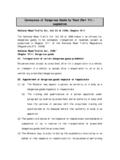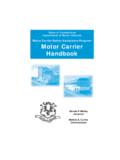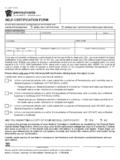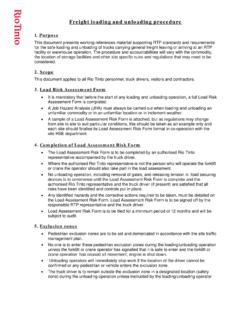Transcription of Convey Dangerous Goods by Road - Part I Signage …
1 Convey Dangerous Goods by road - part I Signage and documentationWarning signsIt is important to remember when transporting Dangerous Goods and hazardous materials that care is taken to display the correct warning signs and safety decals are displayed for the load being carried,especially when the consignment/load is a MIXED LOAD with products of different danger/hazard , warning diamondAs per SANS 10232 (1) Dangerous Goods Placards shall be constructed as follows:-It shall be of size 700 mm x 400 mm-It shall be divided into four zones by black lines (10 mm) and have a black border of 10 mmAABBCCD-It shall be constructed of material that will prevent distortion during road transportation-The background colour shall be as prescribed in the SANS code of practicePlacards for vehicles less than 3500 kg s shall also comply with all the prescribed requirements, but may be of a reduced size 350 mm x 200 PLACARDING FOR VEHICLES CARRYING Dangerous Goods .
2 AABBCCDDB OPERATORTELEPHONICADVICE ZONEC SPECIALIST ADVICETELEPHONIC ZONED HAZARD CLASSDIAMOND ZONEA GOODSIDENTIFICATIONZONE (UN NO:)Single Substance Placard:-UN NO : 1748-CLASS : OXIDIZER-SUBSIDIARY RISK : NONE-SUBSTANCE : CALCIUM HYPOCHLORITES ingle substance placard with subsidiary risk:1748(011) 884 1234(011) 884 23451017(014) 768 7056(014) 577 2649-UN NO : 1017-CLASS : TOXIC GAS-UBSIDIARY RISK : CORROSIVE-SUBSTANCE : CHLORINEM ixed Load Placard:-UN NO : MIXED LOAD-CLASS : UNIDENTIFIED-SUBSIDIARY RISK : UNIDENTIFIED-SUBSTANCE : UNIDENTIFIEDMULTI LOAD(012) 542 1358(016) 428 7070 SPLIT PLACARDING CONFIGURATION:Freight containers shall have split placarding that consistsofa Goods identification rectangle, a hazard class diamond or MIXED LOAD diamond and a subsidiary risk diamond as prescribed.
3 -The Goods identification rectangle shall be of a height not less than 120 mm and of a width not less than 300 mm, the rectangle shall have a black border of width 10 mm and the background colour shall be orange with black Goods identification rectangle shall contain either the UN NO:, or the word MIXED LOAD or the word WASTE followed by the UN NO: as Goods identification rectangle shall be placed adjacent (on either side of) the hazard class diamond and subsidiary risk Number of substanceTOXIC GASMain hazard class warning diamondSubsidiary risk hazard diamondSubsidiary risk hazard diamondWarning signs and safety devices displayed on a vehicle carrying Dangerous Goods or hazardous materials.
4 The vehicle must display an orange warning diamond on the front of 300 mm x 300 mm in vehicle must display 3 x No Smoking decals adjacent to the hazard warning vehicle must display 3 x No Open Flame decals adjacent to the hazard warning vehicle must display 3 x No Cell Phones decals adjacent to the hazard warning placards when carry flammable Temperature warning signs are used for Bulk Tankers carrying liquids or solids where the temperature in the case of Liquids exceeds 100 degrees Celsiusand in the case of solids 240 degrees devices and equipment:Vehicles conveying Dangerous Goods require to be fitted or carry the following minimum safety devices and equipment.
5 -Fitted with an isolator switch-Insulated or PVC battery cover or enclosed in a box-Warning triangles-2 x 9kg DCP fire extinguishers-1 x CO2 fire extinguishers fitted inside the cab for electrical fires-A designated space (orange document bag or holder) for angerous Goods documents during road transportation-A basic first aid kitThe vehicle must display 3 x Elevated Temperature decals adjacent to the hazard warning placards when PPC/PPE (protective clothing & equipment) for Dangerous Goods incidents-A spill kit and/or leak containment equipmentDangerous Goods hazard explosion hazards Dynamite, TNT, detonating hazards Bombs and hand hazards Distress signals, Sodium significant hazards Fireworks, Shotgun insensitive Blasting insensitiveRestricted gases Acetylene, Butane, Calor gas, Aerosols, Hydrogen, LPG, Methane, Propane , non-toxic gases ( Dangerous because they are compressed or harmful for other reasons eg deprive the air of oxygen)
6 Argon, Carbon dioxide, Helium, Oxygen gases (so poisonous or corrosive that they are known to be extremely Dangerous to life) Ammonia, Chlorine, Carbon monoxide, Hydrogen chloride, Phosgene, Sulphur dioxide WarningdiamondSubclassDescriptionExample sFlammable liquids3 Flammable liquids (ignite easily with a flash point of degrees or less) More than 80% of Dangerous Goods transported belong to Class 3. Acetone, Benzene, Diesel, Ethanol (alcohol), Petrol, Tar, Toluene. Methylated spirits, Paraffin, Turpentine Flammable solids (easily lit by spark or flame or which burn readily or which can catch fire through friction) Camphor, Matches, Naphthalene, Red phosphorous, Scrap rubber, Sulphur, Wax polish combustible (liquids or solids which generate their own heat and which will self-ignite when exposed to air)
7 Activated carbon, Cotton waste, Fishmeal, Maneb, Metal shavings, Oil/seed cake, Sodium sulphide, White phosphorous when wet substances (on contact with water may catch fire by themselves or emit flammable or toxic gases) Aluminium phosphide, Calcium carbide, Lithium, Magnesium powder, Sodium, Zinc dust Oxidising (not necessarily flammable in themselves, they can produce large amounts of oxygen increasing the risk and intensity of fire in other materials) Ammonium nitrate, Calcium hypochlorite (HTH), Hydrogen peroxide bleach, Lead peroxides (sensitive to heat are thermally unstable and generate large amounts of heat as they breakdown) Benzoyl peroxide used in acne creams and hair dye, Di-tert-butyl peroxide used to initiate polymerization of ethylene, styrene and vinyl chloride Toxic and Infectious substances (cause illness or death if swallowed, inhaled or if absorbed by the skin)
8 Nearly all emit poisonous gases in a fire Arsenic, cadmium oxide, Cadmium chloride, Creosote, Cyanides, Phenol, Some pesticides substances (contain bacteria, viruses, parasites and fungi which cause disease inhumans and animals) Medical waste, Pathological specimens, Ebola virus WarningdiamondSubclassDescriptionExample sRadioactive Material7 Radio active materials (comprising highly penetrative gamma rays, beta particles which can penetrate skin and alpha particles not hazardous unless swallowed or absorbed through a wound) Type A medical medication, Nuclear fuel, Cobalt, Radium, Uranium, Plutonium Corrosives8 Corrosives (acids and caustic substances in liquid or solid form which chemically eat away a substance and severely damage living tissue)Leakage can also damage other cargo and react with metals used in the construction of vehicles Acid filled batteries, Hydrochloric acid (spirits of salts and pool acid), Sulphuric acid, Quicklime, Iodine, Lye, Potash, Sodium hydroxide (caustic soda drain cleaner)
9 , Soldering flux Miscellaneous Dangerous Goods9 Miscellaneous ( Goods which present a danger but cannot be classified in any of the other classes) They include environmentally hazardous substances. Air bag inflators or modules, Asbestos, Lithium batteries, Expandable polystyrene beads Statutory documentsRegulation 281 of the National road Traffic ActTremcard/TreccardDangerous Goods DeclarationProfessional driving permit PrDP (D)Operators Card/DiscDangerous Goods DeclarationOperational requirementsDangerous Goods declaration-The DGD shall comply with the requirements of SANS 10232-1-The DGD shall be stored in the designated of the DGD shall be retained by the consignor for a minimum of 90 days after thedate of shipment, if no incident is reported.
10 If an incident is reported, the DGD shall be retained for the duration of the relevant of a Dangerous Goods DeclarationTransport emergency cardsA transport emergency card contains the hazards and emergency information for a material being transported in a clear and concise manner. It ensures that the driver of the vehicle transporting Dangerous Goods knows exactly what load he or she is transporting, as well as the risk presented bythe Goods being carried. The card also serves as a concise and quick r







